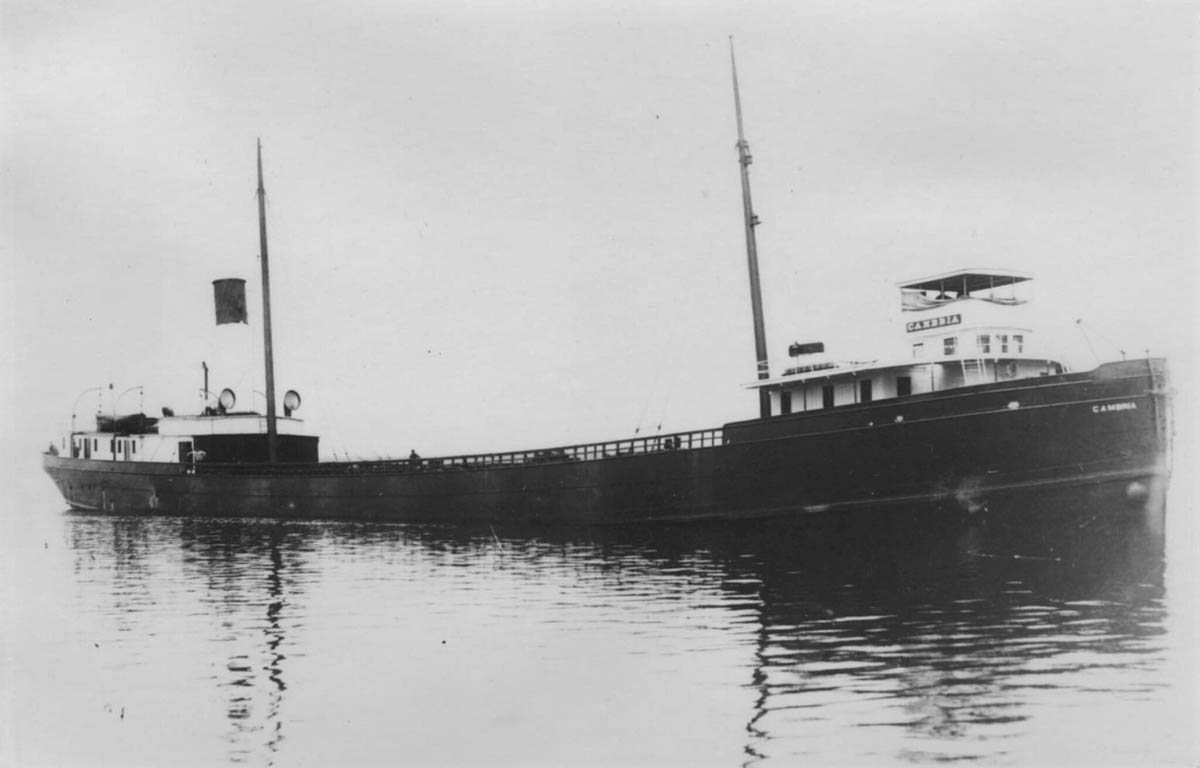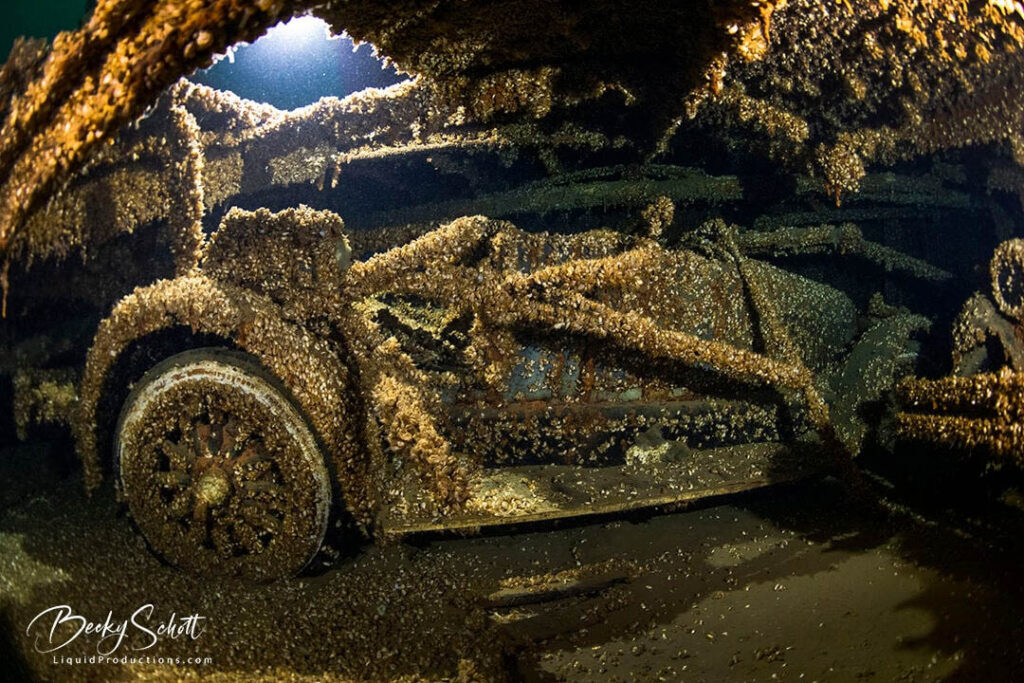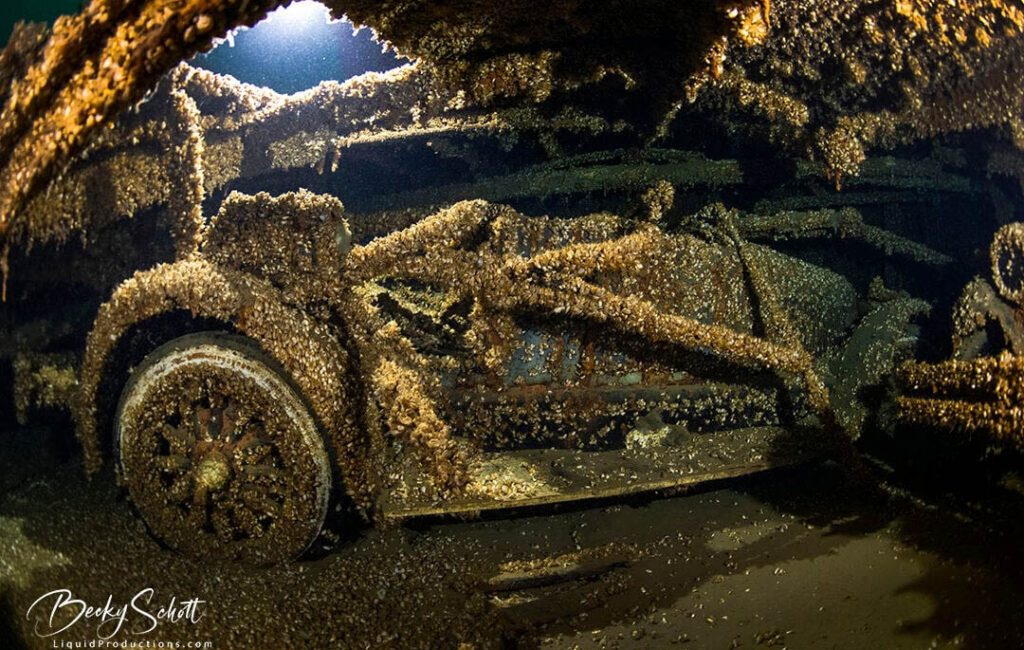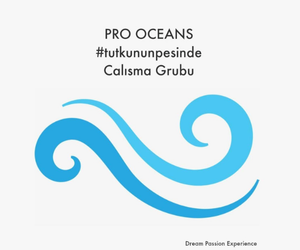The SS Lakeland, one of the early steel-hulled freighters on the Great Lakes, went down on December 3, 1924. The vessel sank in Lake Michigan near Sturgeon Bay in Door County, Wisconsin, settling at a depth of 205 feet (62 meters) after developing a leak.
The vessel known as the Lakeland was originally constructed in 1887 in Cleveland, Ohio, by the Globe Iron Works Company. At the time of her launch, she bore the name Cambria and was notable for being one of the earliest steel-hulled freighters to operate on the Great Lakes. Built for the Mutual Transportation Company, which was affiliated with the Federal Steel Company owned by Elbert H. Gary, she represented a significant advancement in lake shipping technology.
Measuring 300.6 feet (91.6 meters) in overall length, Cambria became the first ship on the Great Lakes to reach the 300-foot mark. Her length between perpendiculars was 280 feet (85 meters), and she featured a beam of 39 feet (12 meters) and a cargo hold depth of 24 feet (7.3 meters). Propelled by a 1,200-horsepower triple-expansion steam engine and powered by two coal-fired Scotch marine boilers, the ship was designed for both strength and efficiency. Her gross tonnage was recorded at 1,878.10 tons, with a net tonnage of 1,377.33 tons.

Detroit Publishing Co., Public domain, via Wikimedia Commons
The Cambria was launched in Cleveland on February 1, 1887, designated as hull number 12. At the time, she was only the second steel-hulled lake freighter built by the Globe Iron Works Company. Notably, she was also the first vessel of her kind on the Great Lakes to feature a triple-expansion steam engine, marking a milestone in marine engineering.
Designed to transport a variety of bulk materials, the Cambria carried loads such as iron ore, coal, grain, and salt, and was later adapted to haul automobiles.
In June 1888, the Cambria encountered trouble when she ran aground approximately two miles (3.2 kilometers) southwest of the Peninsula Point Light on Lake Michigan. At the time, she was loaded with 2,334 tons of iron ore, and the incident caused significant damage, tearing a hole in her hull.
In 1910, the Cambria was brought to the Milwaukee Dry Dock Company with plans to convert her into a passenger vessel. However, the shipyard was unable to complete the work, and the wrecking tug Favorite eventually towed the vessel to Cleveland, where the conversion was finished.
That same year, in May 1910, the ship was renamed Lakeland. A few months later, in September, she was involved in a collision with the steam barge John Smeaton while navigating the St. Marys River. Following the accident, she ran aground.
In the early part of 1920, the Lakeland underwent another transformation—this time from a passenger ship into an automobile carrier.
The Lakeland did not operate during the 1923 shipping season due to a significant overhaul. As part of the refurbishment, her boiler room was relocated, and a new watertight bulkhead was installed. She also received two new Scotch marine boilers, a new pilothouse, repairs to the ballast pump, and replacement of several cracked structural frames.
In the fall of 1924, she entered dry dock in Detroit, Michigan, to address a twisted rudder stock. While in dry dock, inspectors conducted a thorough examination of her hull and rudder.
In 1910, the Cambria was brought to the Milwaukee Dry Dock Company with plans to convert her into a passenger vessel. However, the shipyard was unable to complete the work, and the wrecking tug Favorite eventually towed the vessel to Cleveland, where the conversion was finished.
That same year, in May 1910, the ship was renamed Lakeland. A few months later, in September, she was involved in a collision with the steam barge John Smeaton while navigating the St. Marys River. Following the accident, she ran aground.
In the early part of 1920, the Lakeland underwent another transformation—this time from a passenger ship into an automobile carrier.
The Lakeland did not operate during the 1923 shipping season due to a significant overhaul. As part of the refurbishment, her boiler room was relocated, and a new watertight bulkhead was installed. She also received two new Scotch marine boilers, a new pilothouse, repairs to the ballast pump, and replacement of several cracked structural frames.
In the fall of 1924, she entered dry dock in Detroit, Michigan, to address a twisted rudder stock. While in dry dock, inspectors conducted a thorough examination of her hull and rudder.
Last Voyage
On December 3, 1924, the Lakeland was making a routine voyage across Lake Michigan, traveling from Chicago, Illinois, to Detroit, Michigan. She was carrying a load of 24 automobiles—22 manufactured by Nash and Kissel, and one by Rollin. Although the vessel had been dealing with some minor leaks, they were not considered serious at the time.
However, around 11:30 a.m., a significant leak developed. The crew responded by running the pumps at maximum capacity in an attempt to control the flooding. Despite their efforts, the situation rapidly worsened, prompting Captain John McNeely to reverse course in hopes of reaching shallower waters.
When the ship was approximately nine miles from the shoreline, it became clear that she would not stay afloat. Some of the crew took to the lifeboats as the flooding intensified. The car ferry Ann Arbor No. 6 arrived on the scene and came alongside the Lakeland, but according to reports, Captain McNeely declined a tow.
By the time the U.S. Coast Guard cutter arrived, the Lakeland was dangerously listing to port. Captain Robert Anderson, commanding the cutter, ordered the remaining crew members to come aboard his vessel for safety. The steamer Signus also stood nearby during the incident.
Eventually, the Lakeland sank stern first, breaking apart as she descended. Her deck lights continued to flicker until they finally vanished beneath the surface of the lake.
As she sank, the radio operator on the Ann Arbor No. 6, Elliot Jacobson took some photographs of her.

Lakeland Today
The wreck of the Lakeland was located in 1960, resting upright on the lakebed at a depth of 205 feet (62 meters). Her steel hull remains largely intact, though it is nearly split in two just behind the cargo elevator. The ship’s wooden deckhouses are no longer present, having been torn away during the sinking when trapped air forced them off the hull. The bow’s passenger deck features several fractures, providing entry points for divers exploring the interior.
During the 1970s, a 1924 Rollin automobile was recovered from the wreck. Unfortunately, issues during the salvage operation led to the vehicle being scrapped. Among the items successfully preserved is the Lakeland’s brass steam whistle, which is now exhibited at the Door County Maritime Museum. Her anchor was also raised from the site. Despite the passage of time, several Nash and Kissel cars remain within the ship’s hold.
The Lakeland lies near several other notable shipwrecks, including the large wooden freighters Australasia and Frank O’Connor, the steamer Louisiana—a casualty of the Great Lakes Storm of 1913—the schooner Christina Nilsson, and the steamboat Joys.
The wreck of the Lakeland was officially listed on the National Register of Historic Places on July 7, 2015.
Follow Becky Kagan’s Schott’s Diving Adventures at Facebook and Instagram
THE SCUBA NEWS Link !
DemirHindiSG 23 Temmuz 2025-21:06




